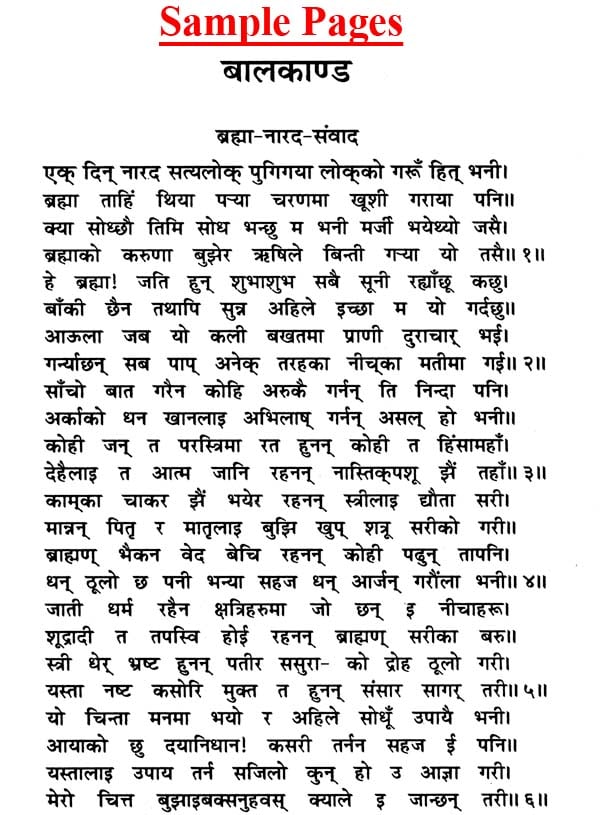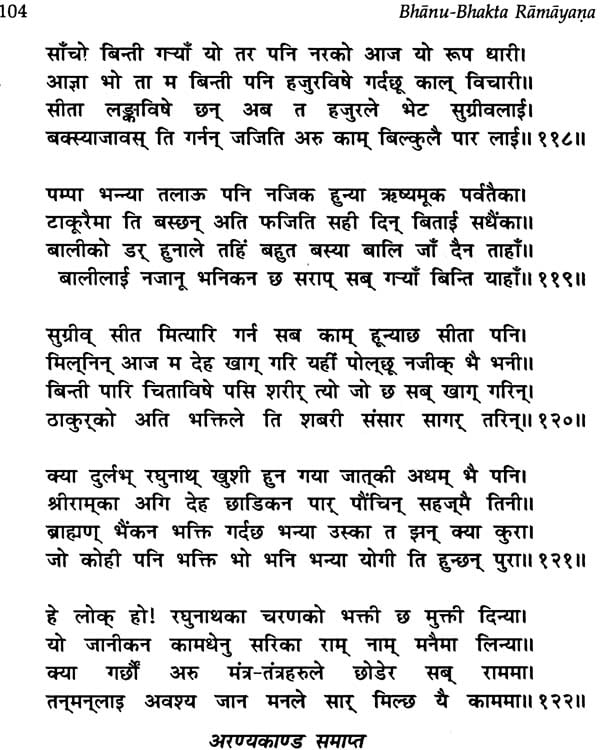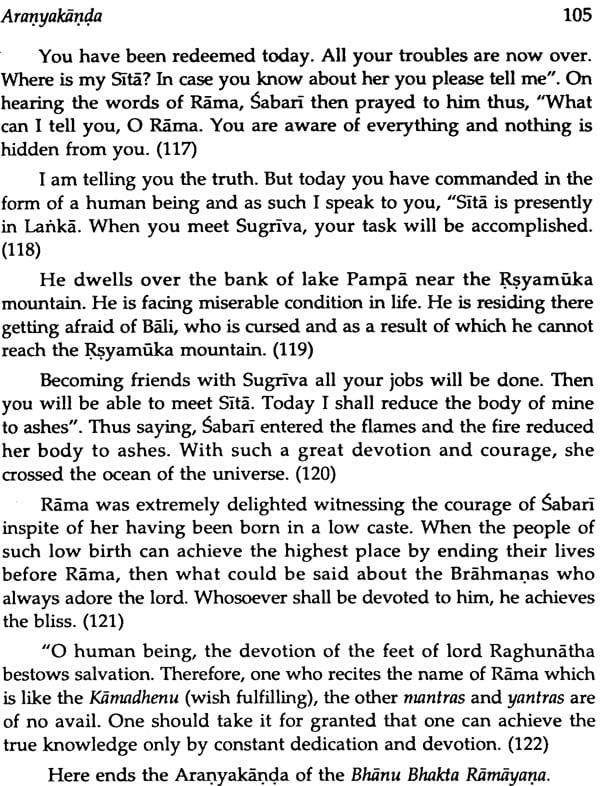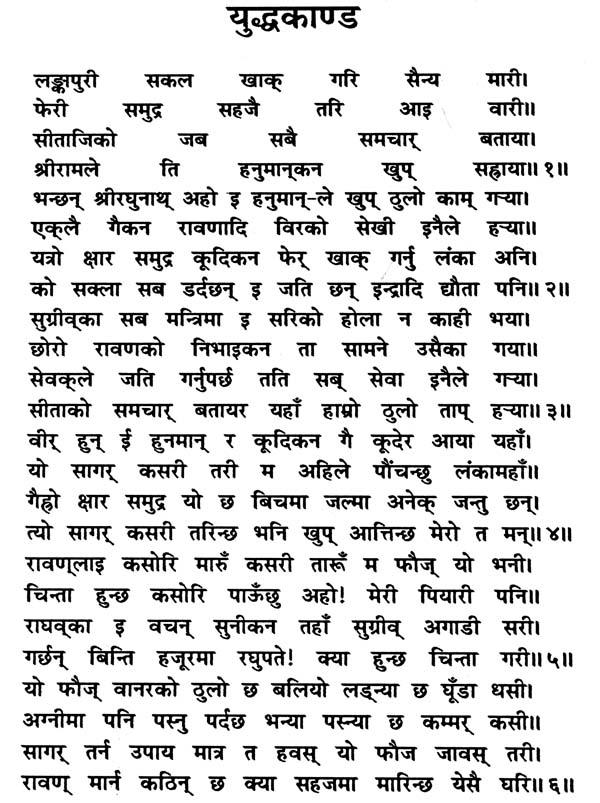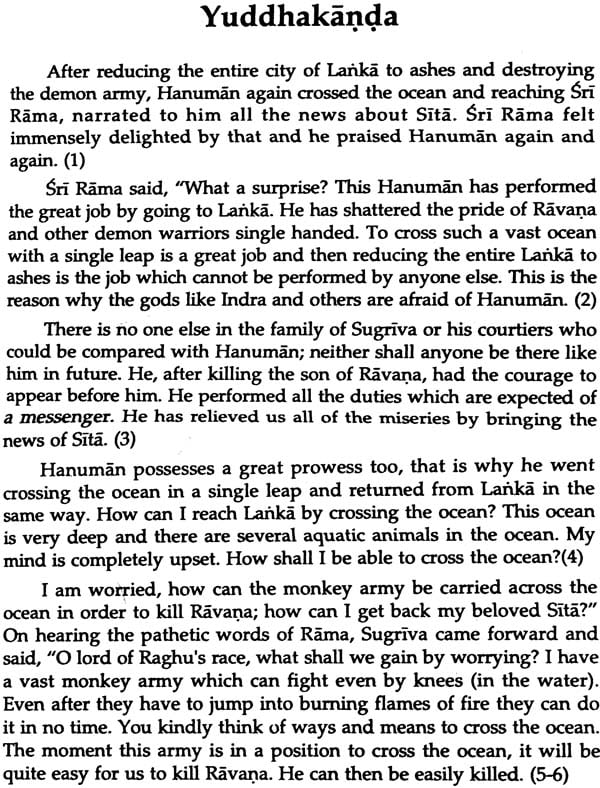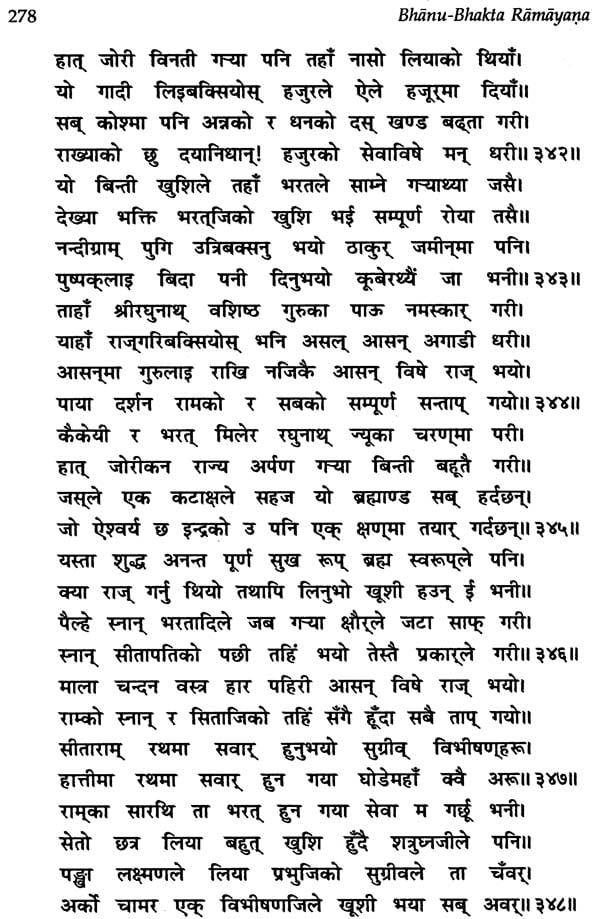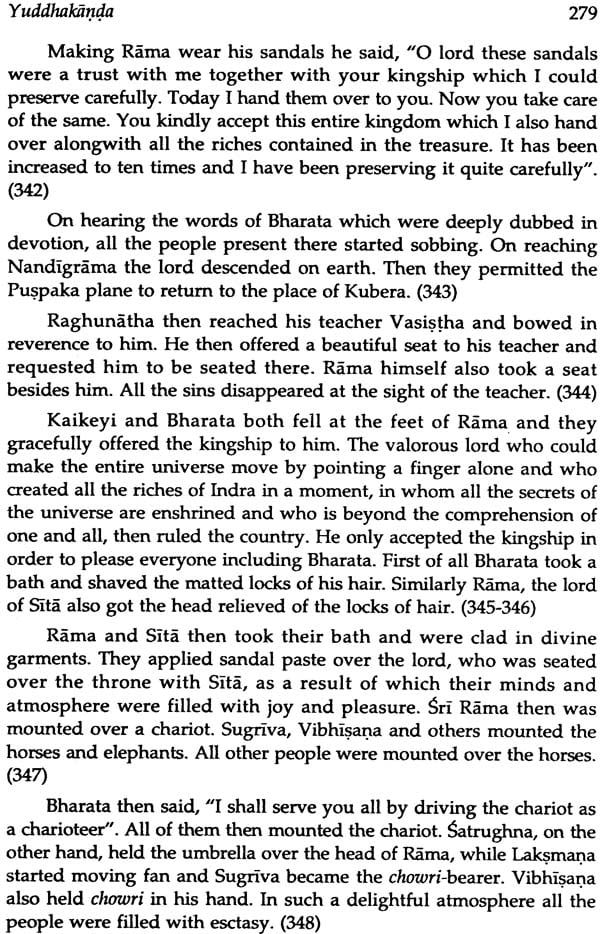
Bhanu Bhakta Ramayana (Nepalese)
Book Specification
| Item Code: | NAP382 |
| Author: | Shantilal Nagar |
| Publisher: | Eastern Book Linkers |
| Language: | Nepalese Text With English Translation |
| Edition: | 2008 |
| ISBN: | 9788178541396 |
| Pages: | 365 |
| Cover: | Hardcover |
| Other Details | 10.0 inch x 7.5 inch |
| Weight | 900 gm |
Book Description
After composing of the Riimayatja by Maharsi Valmiki, the story of Rama, had the mass appeal and was patronised by the people at large. Soon there-after Ramakatha was patronised by the later Sanskrit poets like Kalidasa and others. So' forceful had been the appeal , of Riimakatha among the masses that in due course of time even the composers of the Puranas and other Sanskrit literature, could not resist the temptation of including the said story in the epic of the Mahabharata as well as the other Purarlas in one form or the other. In due course of time there developed a tradition of composing the Ramakatha in the regional languages as well. As a result of this, the work like Kamba Ramayana (Tamil), Madhavakandali Ramayana (Assamese), Krttivasa Ramayana (Bengali), Ramacaritamanasa (Hindi), Girdhara Ramayana (Gujarati) besides in several other languages emerged over the Indian religious horison. Like other Ramayana works, the Bhanu Bhakta Ramayna (in Nepali) was also composed in the 19th century by the great son of the soil, the English version of which has been presented here, for the convenience of the readers.
The author, a graduate of the Punjab University, served in the curatorial capacity in the Central Asian Antiquities Museum, New Delhi, the Archaeological Museum, Nalanda, the Archaeological Section of the Indian Museum, Calcutta for a number of years. He has to his credit the scientific documentation of over fifty thousand antiquities, in these museums, representing the rich cultural heritage of the country and comprising of sculptures, bronzes, terracottas, beads, seals and sealing, ancient Indian numismatics, wood work, miniatures and paintings textiles and Pearce collection of gems, ranging from the earliest times to the late medieval period. He was awarded, in 1987, a fellowship, for his monograph on the Temples of Himachal Pradesh, by the Indian Council of Historical Research, New Delhi. He has been working on the Indian Art, Culture and literature and his more than seventy works have already been published.
The story of Rama has been dominating the Indian religious scene from the time immemorial, the genesis of which, scholars have tried to trace from the Rgvedic literature. Even Maharsi Valmiki composed his work on the Ramayana according to the brief provided to him by Narada, which gives an impression that the story was already well known. The sage, who was known subsequently as Maharsi Valmiki and earned the glory the world over, by being the first celebrated poet of the country, was not at all a scholar by birth, but according a tradition, he happened to be a robber who lived on plundering the riches of others. So degraded was he, it is said, that when he was patronised by Brahma for initiating him as a mendicant, he was asked to go to a stream and have a bath in its water. Ratnakara, by which name he was initially known, then went to the stream for the purification of his body. But no sooner did he cast his glance over the river, its water dried up. Ratnakara then had to return from the bank of the stream quite disappointed. He reported the incident to Brahma, who drew his attention towards a blossoming tree, but when Ratnakara looked at it, the same too dried up. All its branches and leaves fell on the ground and only a trunk remained there. When Brahma asked him as to what it was, Ratnakara replied that it was a dead tree. This is the one extreme of the character of Maharsi Valmiki that in the early stage of his life, he was so sinful that he earned his livelihood by killing human beings and plundering their belongings. So much so, that even the water of the stream and the blossoming tree also dried at his very sight.
Then came the second stage of his life, when he was initiated by Brahma with the sole intention of the purification of his soul. Instead of making him recite the name of Rama he was advised by Brahma to recite mara, the repetition of which amounted to nothing else than reciting the name of Rama. Because Ratnakara could not purify his body by taking a bath in the river, the water of which dried up, Brahma purified Ratnakara by sprinkling over him the sacred water out of his kamandalu. He was then initiated to recite the Mara-mantra. Discarding the worldly pleasures, Ratnakara seated himself under the shade of a tree and kept himself engaged in the recitation of the Mara-mantra. He continued this tapas for many years. So deeply was he absorbed in his tapas that the white-ants made a mound of the earth over his body. This earned him the name of Valmiki. This indeed was the second stage of his life when he earned the title of Valmiki which brought a total change in his worldly outlook. Instead of a robber, he was transformed into a recluse, unconcerned about his own comforts of life.
The third stage of his life was projected when Maharsi Valmiki, while wandering in the forest aimlessly, came across an incident, in which, a hunter shot an arrow at one of the two birds engaged in love-sport in the charming environments of the forest greenery and the flowers. The cries of the hurt bird deeply penetrated into the heart of the sage to such a great extent that he unmindfully uttered a verse, pronouncing curse on the hunter—
माँ निषाद प्रतिष्ठां त्वमगम: शाश्वती समा:।
यत्क्रौन्च मिथुना देकमवधि काममोहितम
This indeed is considered to be the first Sanskrit verse and the fore-runner of the meteric excellence of the Valmiki Ramayana. Indeed it is surprising that the same Ratnakara who found no fault in the killing of human beings quite frequently, underwent such a tremendous mental change, that even the cries of an innocent bird of the wild forest could move his mind to such an extent that he could not resist the temptation of the pronouncing of a curse on the hunter. This is the height of the emotion displayed in the character of Maharsi Valmiki and this could possibly be the reason, that the text of the Valmiki Ramayana is sometimes found to be highly emotional.
Initially Maharsi Valmiki was unaware of the story of Rama, which had been quite popular with the masses in fragments. The brief of the said story was, however, provided by Narada to Maharsi Valmiki, which served as the basis of his composition. Evidently Maharsi Valmiki himself collected several bits of the story by travelling a lot and composing his work in an extensive manner.
There is a school of thought, particularly comprising of the foreign scholars who believe that the idea of devotion or bhakti is of later development in the country. But taking into consideration the devotion with which Maharsi Valmiki recited the name of Rama, though unmindfully, the devotion of Sabari towards Rama, the devotion of Bharata, Laksmana and Hanuman towards Rama, the entire theory would need a review. Indeed the entire work of Valmiki could be termed as the devotional poetry, the parallel of which is difficult to be found in the universe. Once the story of Rama was composed in a definite form, by Valmiki, there happened to be a great boost in the popularity of the story of Rama and it became more accessible to the masses, who felt more and more inclined to have greater access to the same. Since the work of Valmiki was in chaste Sanskrit and the masses had to depend on others for knowing the details about it, soon there developed an urge with the masses to have the text of Ramayana, in the languages they could well understand themselves. This had been the reason, why, after the Valmiki's Ramayana, several works in regional languages were composed not only in India, but also in other countries of the world.
Of the several Ramayana works composed in the regional languages in the eastern parts of the country, mention may be made of the Madhava Karidali Ramayana (14th century A.D.), Krttivasa Ramayana (15th century A.D.), Ramacaritamanasa by Tulsidasa (16th century A.D.). Of course, the Bhanu Bhakta Ramayana happens to be the latest of all, having been composed in the 19th century A.D.
Bhanu Bhakta composed his work in the Nepali language, during the period when it was not considered appropriate to compose any religious work in any language other than Sanskrit. Inspite of the fact that his father and the grand father were great Sanskrit scholars of their times, still Bhanu Bhakta preferred to compose his work in the regional language (Nepalese), in the Sardulavikridita and Vasantatilaka metres. The composition is of high poetic excellence.
In this translation work, I have been guided by the Hindi translation of the Bhanu Bhakta Riimayana brought out by the Bhuvan Vani Trust, Luknow and I am, therefore, immensely indebted to the Trust for bringing out such a useful publication for the benefit of the masses. This indeed is one of the series of the translation works of Ramayana of regional languages undertaken by me and I am sure, will appeal the readers.

